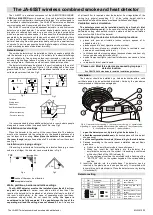
Teardrop Campers • nucamprv.com
54
Teardrop Campers • nucamprv.com
55
Waxing.
Wax the camper exterior twice a year. The use of automotive waxes or cleaners/polishes that
are for use on fiberglass or boats are acceptable. Ask for recommendations from your dealer if you are
unsure of what to use. Exterior streaking, corrosion, staining, or chemical spotting can be reduced with
frequent waxing. Always wash and dry the camper before waxing it.
STORAGE PREPARATION
Unless you live in the sunny south, you will need to prepare your camper each fall to face the cold
winter months. It is very important that you follow the instructions in this section to properly care for
your camper. The best practice for storing your camper is to store it indoors in a warm controlled
climate (above 40°) and lifted off the ground on jack stands to relieve pressure on tires. Indoor storage
also lessens the amount of work needing to be done for storage preparation. Two different ways of
storing your camper are outlined below.
Outdoor Storage:
1. Winterize the plumbing system. This is crucial in temperatures below 32°.
2. Clean your RV as outlined in the cleaning care instructions.
3. Turn off electrical switches and all 12V DC/120V/propane gas appliances.
4. Shut off the propane gas cylinder (LP tank) main valve.
5. Cover the external outlets, vents and windows of your RV to prevent moisture, mice or rodents
from entering.
6. Check the interior of the RV for leaks or any formed condensation that can cause damage to
interior components. To help reduce condensation from the interior, occasionally air out the
camper during storage.
7. Cover roof air conditioner if so equipped.
8. Disconnect the 120V AC power.
9. Charge batteries to full capacity to avoid freezing and cracking in the case. In storage, a battery
will gradually lose charge after 30-45 days. Check the battery once a month and if the charge is
at 80% or less, recharge it.
10. Check the tire pressure monthly and keep tires fully inflated.
11. If possible, lift the trailer onto jack stands to relieve pressure on tires.
12. Cover tires with appropriate tire covers.
13. During the storage period, keep the roof of the camper free of snow and ice to prevent damage
to the unit’s structure.
14. For best results when storing outdoors, cover your entire camper with an RV cover to protect it
from the elements.
Indoor Storage:
1. Clean your RV as outlined in the cleaning care instructions.
2. Turn off electrical switches and all 12V DC/120V/propane gas appliances.
3. Shut off the propane gas cylinder (LP tank) main valve.
4. Disconnect the 120V AC power.
5. Charge batteries to full capacity. Check the battery once a month. If the charge is at 80% or less,
recharge it.
6. Check tire pressure monthly and keep tires fully inflated.
7. If possible, lift the trailer onto jack stands to relieve pressure on tires.
CAMPING SEASON PREPARATION
Preparation for the camping season (or at any given time):
1. Open vents and windows and air out the camper. Turn on ventilating fans.
2. Check water, gas and any other pipelines or tubes for insects such as spiders and mud dauber
wasps that frequently build nests and clog tubes. This can be especially dangerous in gas
pipelines as gas can become trapped and carbon monoxide may result and cause death.
3. Clean the camper thoroughly. Inspect the trailer for caulking failure, water damage, and rodent
or insect intrusion.
4. De-winterize and sanitize the fresh water system in your camper. See instructions on
pages 37.
5. Pressurize the water system and check for leaks by operating every faucet and water outlet and
observing fittings and connections for leaks.
6. Inspect the electrical system. Check power cords, converter, outlets and wiring for damage.
7. Check battery terminals for corrosion, turn on battery switch, and check battery charge levels.
8. Check circuit breakers and fuses in the converter box for function.
9. Test all the lights and other accessories for proper function.
10. Check the propane piping for leaks. If no leaks are found, slowly turn on LP tank valves.
11. Turn on appliances one by one and test with propane and/ electricity for proper function.
12. Put a new battery into the smoke alarm. Ensure all safety alarms are working properly.
13. Follow manufacturer instructions for each component’s operation.
14. If any issues are found in your trailer and you cannot perform the maintenance yourself, consult
your authorized nuCamp dealer for assistance.








































